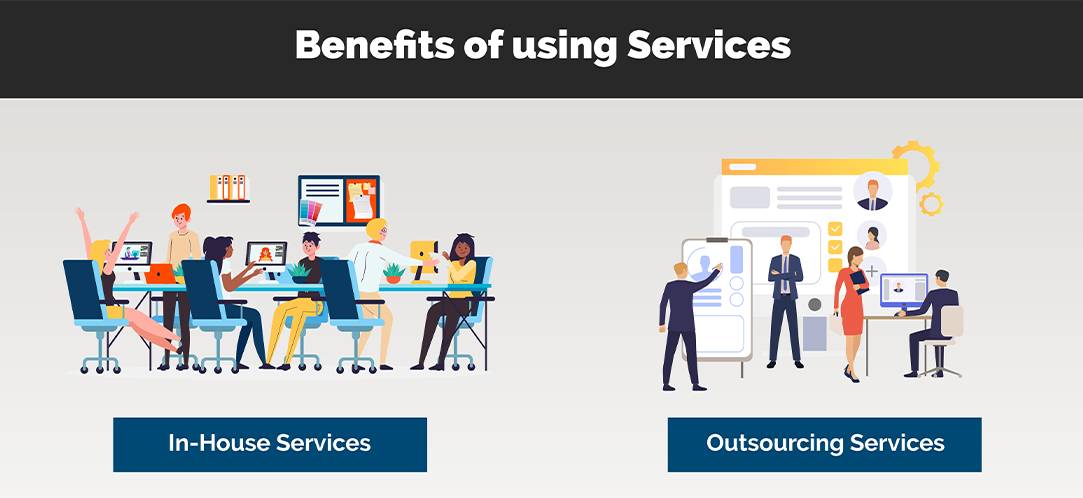IT Outsourcing services involve engaging external service providers to efficiently deliver IT-enabled business processes and solutions for optimal business outcomes. This practice can yield cost savings for businesses, but only if approached with careful planning and management to avoid a financial drain. Statista projects that the IT Outsourcing market’s revenue will reach a staggering £460.10bn in 2023.
Enterprises can leverage outsourcing to decrease expenses, speed up product launches, leverage external expertise, and focus resources on core business development. Despite the significant advantages that IT outsourcing can bring, small businesses and startups remain skeptical about its potential costs. Many presume that outsourced IT services will cost significantly more than maintaining an in-house team, but this is typically not true.
In reality, partnering with a reputable IT outsourcing company can result in significant cost savings. Understanding the real costs of IT outsourcing is crucial for maximizing your investment.
This Guide will delve into the various reasons that drive companies towards IT outsourcing, while also exploring the different types of outsourcing options. Additionally, we will consider the factors that impact IT outsourcing costs and delve into cost-benefit analysis. Finally, we will examine emerging trends in the IT outsourcing landscape.
Go on, Read.
Understanding IT Outsourcing
Outsourcing IT services is a popular business strategy that involves hiring external providers to manage specific technology functions, activities, or processes. Companies can streamline operations and achieve desired outcomes by leveraging third-party resources while focusing on core tasks.
Managed service providers, IT consultants, and IT solution providers are commonly used as external vendors to handle various aspects of the IT business. These experts may offer outsourced IT support services for business processes, infrastructure solutions, application services, cloud-enabled services, and software as a service to help develop effective outsourcing strategies and vision.
The most commonly outsourced IT services include web development, hosting, software and application development, website/application maintenance or management, technical support, database development and management, telecommunications, and IT infrastructure.

Why Companies Choose IT Outsourcing?
- Cost Benefits
Through IT outsourcing, businesses can operate within a set budget due to the contract basis, providing transparency and clarity in service expenditures. With the financial benefits of outsourcing, companies can redirect funds towards other areas of operations, maximizing productivity and profitability. Outsourcing can reduce expenses in labor, operations, and maintenance, thereby improving overall efficiency and cost-effectiveness.
- Saving Time
By outsourcing software development, businesses can effectively multitask and focus on other essential areas of their operations while IT tasks are competently handled by expert professionals. This approach to managing IT operations helps companies to save valuable time and optimize productivity.
- Access to More Talent
IT operations outsourcing provides a significant advantage by granting access to a broader talent pool. The workforce is not limited and can be easily accessed through various models such as onshoring, offshoring, and nearshoring. With IT Outsourcing, companies can incorporate external expertise with their internal resources to enhance their overall performance. This approach allows access to top-tier developers with exceptional technical skills and capabilities.
- Scalable Resources works for Innovation
Efficient access to relevant resources can enhance the hiring process and provide convenient and flexible options for scaling up or down as required. Meanwhile, prioritizing creativity and Innovation in IT outsourcing enables companies to introduce fresh ideas to the market and remain competitive.
- Future-proofing
Entrusting IT operations to MSPs helps businesses embrace the latest technology trends and innovations without additional costs. MSPs ensure that businesses are equipped with the latest technological advancements. As a result, businesses can maintain a competitive edge, streamline their operations, and accelerate their innovation processes.
Types of IT Outsourcing
The act of outsourcing involves delegating certain tasks to external parties, whether they are located domestically or internationally. This encompasses a variety of concepts, each with its distinct advantages and considerations. Companies must carefully assess their goals and requirements to determine the most suitable approach for their specific needs. Geographical proximity defines the type of outsourcing engagement, whether it’s offshoring, nearshoring, or onshoring.
Onshore, Nearshore, and Offshore Outsourcing
- Offshoring
Benefits of offshoring entail outsourcing IT-related activities to external service providers located in distant regions, typically to take advantage of more favorable economic conditions, access specialized talent pools, or enter emerging markets. Although it involves significant differences in geography, culture, and time zones, the time differences can benefit customer-oriented companies that require 24/7 tech or help-desk support.
- Nearshoring
Nearshore IT outsourcing has one crucial difference from offshoring. In this model, organizations outsource IT functions to a country much closer to their location, typically within the same region. This results in smoother communication between the in-house team and the remote service provider since they are in the same time zone or within a few hours. Furthermore, the proximity of the two teams often leads to cultural affinity, which in turn promotes collaboration and productivity.
- Onshoring
Onshoring, or domestic outsourcing, involves delegating various business processes to a different location within the same country. This practice is typically implemented to assist local businesses in ensuring operational control. Onshore outsourcing is in high demand because it reduces travel costs and saves time. Global companies often prefer this outsourcing model due to shared time zones and cost savings.
Managed IT Services vs. Project-Based Outsourcing
Managed IT services vs. project-based outsourcing, are two different approaches that can help organizations achieve their technological goals.
Managed IT services involve outsourcing the entirety of IT management to a third-party provider, where the provider handles everything from software and hardware maintenance to data backup and security.
Project-based outsourcing, on the other hand, is the act of delegating specific IT projects or tasks to an external vendor or contractor.
Both strategies have advantages and drawbacks, and the best approach will depend on an organization’s specific goals and resources. In summary, managed IT services and project-based outsourcing provide distinct approaches to IT management and support. Organizations can choose the strategy that best aligns with their goals, priorities, and resources to drive technological advancements.
Factors Affecting IT Outsourcing Costs

The global business landscape has transformed dramatically in the last decade, with many organizations embracing the trend of IT outsourcing. Outsourcing provides several advantages, such as cost-effectiveness and access to specialized skills, but there are several factors to consider before engaging with outsourcing vendors.
- Labor Costs:
The outsourcing destination is a crucial factor when considering labor costs. Different regions have different wage rates for IT professionals. For instance, Asian countries like India is a preferred outsourcing destination because of their relatively low wages. In contrast, North America and Western Europe are considered high-cost regions.
Another aspect of labor costs is the total cost of ownership (TCO), which incorporates factors like onboarding, training, productivity, and attrition rates. When evaluating outsourcing partners, it’s crucial to consider total cost of ownership (TCO) to ensure that you’re accounting for both immediate services and long-term cost-benefit analysis.
- Infrastructure and Technology Costs:
Hardware, software, and licensing requirements play a significant role in determining outsourcing costs. Infrastructure and technology costs vary across merchants and geographical regions. Sometimes, providers may have outdated equipment that doesn’t align with your organization’s standards. Such vendors may charge you more for additional requirements to suit your specifications.
It’s also important to consider vendor expertise, especially when it comes to specialized technology needs. Some vendors may require extensive training to use your specific tools and equipment, which translates to higher outsourcing costs.
- Hidden Costs in IT Outsourcing:
Besides the visible costs, outsourcing comes with hidden expenses, which are critical to the overall outsourcing budget. Hidden costs may include communication overhead, quality assurance, compliance, and risk management.
One way of mitigating these hidden costs is through robust service level agreements (SLAs). The SLA defines the scope of work, turnaround time, and penalties for non-compliance, ensuring transparency and accountability throughout the outsourcing engagement.
Cost-Benefit Analysis for IT Outsourcing
The potential for cost savings and revenue gains is significant when considering IT outsourcing. However, ensuring that the investment made will provide a long-term payoff is essential. Calculating the return on investment (ROI) is critical in the decision-making process and is achieved by dividing the net gain by the investment cost. The next step involves conducting a thorough cost-benefit analysis, which can be challenging, particularly for first-time outsourcers. This analysis requires weighing both quantifiable and qualifiable costs and benefits.
- Analyze Your Processes
Defining your strategy and goals is the first and most crucial step in conducting a cost-benefit analysis for outsourcing. Start by analyzing your current processes and identifying the ones that can be automated. It is also crucial to outline the goals and expected outcomes you want to achieve from the transition.
- Calculate In-house Costs
Before conducting a cost-benefit analysis for an outsourcing project, it is imperative to accurately calculate the expenses associated with performing tasks in-house. It is crucial to meticulously evaluate all relevant factors and list all expenses related to the processes in question.
The following are the expenses that make up the cost of hiring an in-house developer:
– Cost per hire.
– Developer salary.
– IT expenses.
– Software licences.
– IT system.
– Technology training.
– Paid benefits.
– General expenses.
- Analyze Potential Benefits
Outsourcing IT can provide numerous benefits for companies. It can streamline business processes, reduce costs, and improve efficiency. Additionally, outsourcing allows companies to benefit from customizable IT solutions that are tailored to meet their specific business needs.
How Outsourcing Can Reduce Overall Costs?
Outsourcing is a strategic business decision that can bring about significant cost reductions for companies. By outsourcing certain tasks or services, businesses can save money on labor costs, infrastructure, technology, and other expenses associated with in-house operations. There are several reasons why companies choose to outsource, including:

- Major Wage Differences
Outsourcing to countries with lower labor costs can result in significant savings for companies, as they can pay lower wages to outsourced workers while maintaining high-quality work.
- No Training or Recruitment Fees
When companies outsource, they do not have to worry about recruiting and training new employees. This can save companies a lot of money, as recruitment and training are often costly and time-consuming.
- Significant Infrastructure Savings
The outsourcing provider is responsible for providing the necessary infrastructure and equipment. This can save companies a lot of money in the long run.
- Refocused Budgets
Outsourcing allows companies to refocus their budgets on other core business activities. Companies can use the money saved through outsourcing to invest in other business areas, such as research and development, marketing, or product innovation.
Quality vs. Cost in IT Outsourcing
Maintaining a balance between cost reduction and service quality is a crucial aspect when it comes to IT outsourcing. Companies often resort to IT outsourcing as a means of saving costs, but this may lead to a compromise on the quality of services provided.
Best practices for achieving the balance between Cost and Quality in IT Outsourcing:
- Have a well-defined outsourcing strategy
Before outsourcing, defining an outsourcing strategy that outlines the organization’s objectives, requirements, and expectations is essential. This strategy should include detailed plans to monitor the service quality and measure cost savings.
- Engage in ongoing service provider
It is critical to continually engage with vendors and ensure they meet the organization’s service quality requirements. Conduct regular audits to ensure the vendors deliver quality services at optimal costs.
- Ensure clear communication
Ensure the outsourcing agreements have clear and precise communication protocols outlining roles and responsibilities, processes, and escalation procedures. This ensures there are no gaps in communication and everyone is working together towards achieving the organization’s objectives.
Boost Your Business with Our IT Outsourcing Solutions.
IT Outsourcing vs. In-House IT Operations
In-House IT Operations
By keeping operations in-house, companies can exercise greater control and minimize the risk of miscommunication inherent in outsourcing to a third party. Despite being a pricier option, some companies may prefer in-house services because they align more closely with the company culture.
Benefits of using in-house services
- Talent Development
- On-site Availability
- 100% visibility of work
- Data protection
- Same work timezone
- Better communication
IT Outsourcing
Outsourcing is a business practice in which a company hires an external organization or resource to carry out a project instead of using its in-house employees and resources. This approach helps organizations to save costs and focus on their core competencies by outsourcing non-core activities to external parties. It also allows the in-house employees to concentrate on other important projects, thereby increasing productivity and efficiency.
Benefits of using Outsourcing services
- Cost-Effective
- Core Competencies
- Risk Mitigation
- Quick Team Change
Making a choice Between In-House vs Outsourcing
Deciding between in-house staffing and outsourcing is a critical decision for any business. Though employing a dedicated team in-house may appear effortless, it comes with its set of complexities. Searching for and preparing the ideal candidate for the role is a considerable challenge and cost at every stage.
However, assessing your circumstances and requirements can reveal whether hiring an outsourced team could be advantageous. Outsourcing can alleviate much of the planning and execution burden, enabling you to concentrate on tasks that necessitate your involvement.

Selecting an IT Outsourcing Partner
Are you planning to outsource your IT department? Selecting the right partner can make a huge difference. To ensure you choose the best outsourcing vendor, we’ve outlined the key criteria you need to consider:
Expertise: You must choose a vendor with the relevant skills and experience to meet your IT needs. Review their technical capabilities and ensure they can handle your systems, software, and applications.
Reputation: Research the vendor’s reputation in the industry, read reviews from previous clients, and check their financial stability. If the vendor has been in business for many years, this could indicate their stability.
Cost Competitiveness: While cost should not be the only factor, it is still important. Get multiple quotes from different vendors and compare the prices to ensure you get the best value for your money.
When negotiating IT outsourcing contracts, follow these tips:
- 1. Define the scope of work – Outline the work that will be done, timelines, and performance standards.
- 2. Review pricing – Check if there are any hidden fees and negotiate a price that is both cost-effective and fair.
- 3. Contract Length – Ensure you have an exit strategy in case the vendor doesn’t deliver or the relationship isn’t working.
Additionally, Review termination clauses to ensure no hidden fees or costs are associated with terminating the contract early. - 4.Confidentiality and data protection – Ensure the contract covers all confidentiality and data protection measures to avoid data breaches.
Real-Life Outsourcing Case Studies From Tech Giants
- Slack
Slack has an inspiring tale of growth and success in outsourcing. After enlisting the help of Canadian design team MetaLab to refine their beta version, the company’s valuation soared to £5 billion in July 2017 and continues to rise. Further outsourcing for website design and mobile app development garnered additional investments and propelled their progress even further. The success of Slack is a prime example of the many benefits of IT outsourcing, with MetaLab providing crucial feedback that helped the tool attract a staggering 15,000 users in just two weeks after launch.
With a presence in more than 180 countries and a user base exceeding 1.5 billion, WhatsApp is a hugely successful enterprise. The founders of this innovative messaging app realized that outsourcing was the most effective way to build their product with their limited cash reserves. To minimize operational expenses and obtain access to top-tier developers, they enlisted the services of skilled app developers from Russia. Their decision has paid off as WhatsApp has surged to become the third most popular Android app in the Google Play Store, with an active user base exceeding 2 billion.
- Skype
Skype is a widely recognized telecommunications application that facilitates video and voice calls across various internet devices. To bring their innovative product to fruition, Skype enlisted the help of talented European web developers, acknowledging the necessity for professional web development services. Skype has earned almost 1 billion downloads through its decision to outsource and boasts a monthly active user count of over 300 million, solidifying its success.
Emerging Trends in IT Outsourcing
According to Gartner, the IT outsourcing industry witnessed significant progress, with an expenditure of over $4.4 trillion in 2022. Some popular emerging trends were cloud computing, blockchain technology, artificial intelligence, and other comparable technologies. As we move towards 2023, it’s interesting to note which trends will endure and what novel developments we can expect in the IT outsourcing industry.
- Cloud Computing
As one of the top trends in IT outsourcing for 2023, cloud computing provides access to advanced technologies like AI, RPA, and machine learning, allowing businesses to efficiently collect, store, and utilize cloud-based resources and services. As a result, companies are seeking out experienced cloud engineers and developers who are skilled in managing cloud infrastructure and ensuring the security of their data.
- Automation
The use of automated tools to manage routine IT tasks such as software updates, system maintenance, and security patching is becoming increasingly prevalent in the business world. As a result, there is a growing need for IT outsourcing providers that can offer automation solutions to streamline business processes.
- Cybersecurity
According to the findings of Deloitte, a significant 64% of respondents have expressed their concern over security capabilities as the key driver for the implementation of emerging technologies in the next three years. In response to this concern, organizations are now seeking out third-party providers who offer advanced cybersecurity solutions. These solutions include a wide range of services, from managed security services to cloud-based security platforms, all of which can provide extra protection against malicious attacks.
- Artificial Intelligence (AI)
Businesses can use Artificial Intelligence (AI) tools to enhance customer experiences, optimize operations, and reduce costs. Integrating AI technology gives businesses increased control over their data and processes, resulting in seamless operation. Companies are heavily investing in AI technology to improve user experience by handling and mining large volumes of data. Rather than creating their own AI tools and strategies, many businesses prefer to outsource this function to save time and resources.
Conclusion
If you are facing budget constraints and do not have access to a proficient in-house team equipped with cutting-edge technology, outsourcing can be an excellent option. However, it is essential to remember that saving costs should not be the only reason for choosing this path.
At Nethues, we believe that outsourcing can help you streamline your operations and focus on expanding your startup while reducing costs. As your outsourcing partner, we offer comprehensive solutions ranging from web development to app development and IT services. Therefore, there is no need to delay – consider initiating your outsourcing journey today to experience these benefits.
Frequently Asked Questions
Q1.What are the typical cost savings in IT outsourcing?
Ans: Outsourcing IT services can reduce labor costs by up to 50% and overhead expenses by 25%. However, the potential savings differ depending on the outsourcing model and location.
- Offshore outsourcing offers the most cost savings due to the lower labor costs in countries such as India, China, and the Philippines. This model involves outsourcing IT services to a foreign company in another country.
- Onshore outsourcing involves outsourcing IT services to a company in the same country. This model offers a lower risk of cultural and language barriers but does not provide as much cost savings as offshore outsourcing.
- Nearshore outsourcing is a hybrid of offshore and onshore outsourcing. It involves outsourcing IT services to a neighboring country, offering some cost savings due to lower labor costs but with fewer cultural and language barriers.
Q2. What are the risks of IT outsourcing?
Ans: While IT outsourcing offers numerous benefits, it also comes with various risks.
- Security risks
One of the biggest concerns with outsourcing IT is the potential for a security breach. Companies often share sensitive information with their third-party vendors, and if the vendor’s security system is compromised, it can result in significant data loss and damage to the company’s reputation. To mitigate this risk, selecting a vendor with a proven track record in cybersecurity is crucial.
- Communication breakdown
Communication is crucial to the success of any IT outsourcing project. The project may fail if there is a communication breakdown between the company and the vendor. To mitigate this risk, it is essential to establish clear communication channels with the vendor from the outset. This includes defining the project scope, timelines, milestones, and deliverables and having regular progress meetings to keep the project on track.
- Loss of control
Outsourcing IT means that a company loses control over its outsourced technology. This can be risky because the vendor may make changes without consulting the company, resulting in potential system errors. Companies must set clear guidelines and control mechanisms with the vendor to mitigate this risk.
- Lack of transparency
Companies outsourcing their IT also face the risk of lack of transparency from their vendors. This can result in unexpected costs and a lack of visibility into how the project is progressing.






